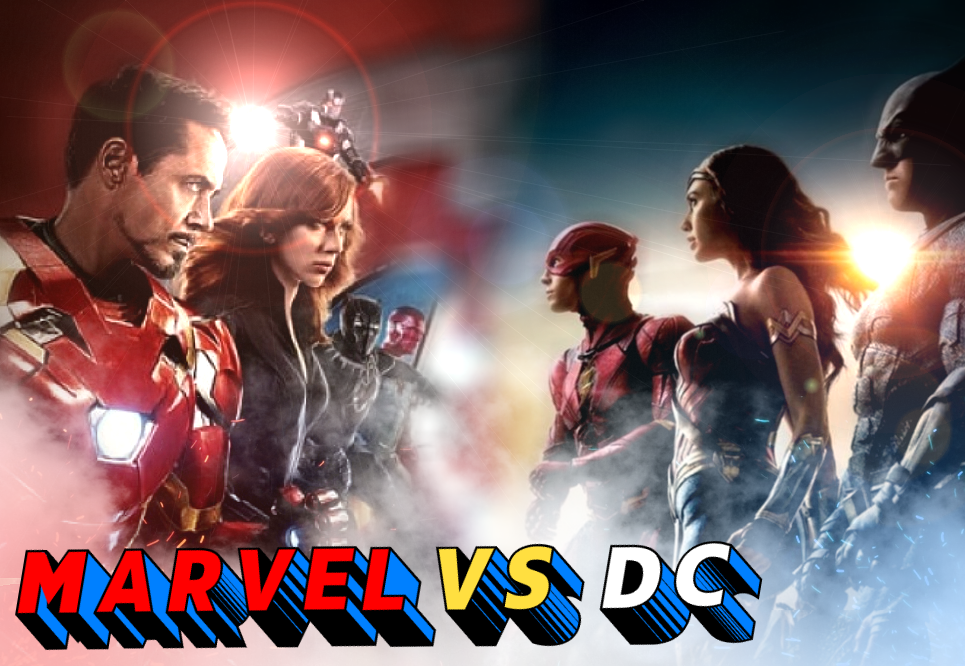
Battle of the superheroes / Photoshopper: Thian Armenia
Marvel (by Thian Armenia):
Back in the late 2000s, it would have been next to impossible for anyone to predict just how big of an influence Marvel would have in the next decade. In 2008, Marvel Studios, at the time a subsidiary of the Marvel Entertainment Group, put to theaters it’s flagship movie: “Iron Man”. It went on to shatter all expectations.
Starring actor Robert Downey Jr., the movie is an origin story adaptation of the comic book version of “Iron Man”. Surprisingly, for such a nerdy premise (sorry), the movie made well over $500 million at the box office. It was likely this stunning performance that piqued the Walt Disney Company’s interest in the project. In 2009, Disney purchased Marvel Entertainment for a mind-boggling $4 billion and subsequently earned quadruple their investment over the next decade.
The now 23 movie collection known as the Marvel Cinematic Universe (MCU) has not only cemented its reputation as one of the largest interconnected series of movies but also assured its many fans of its outstanding quality. Objectively speaking, the MCU has some of the most successful movies of all time with multiple earning more than a billion dollars at the box office. Disney owns seven of the top ten highest-grossing movies of all time, and three of those seven are part of the MCU, including “Avengers: Endgame”, which holds the number one spot.
Because this movie format has proved so successful, the past decade has seen the rise of many similar companies trying to emulate that success with their own series. And… good for them. That’s what having a free market means: anyone can give success a shot. A free market also means, however, that there is no guarantee to see that success. To that end, no other cine has been quite as profitable for its parent company as the MCU is for Disney.
DC comes close, with many of their films hitting the one billion dollar mark, but has not seen quite the pop culture fame as Marvel. And, pop culture is often the driving force behind which movies are remembered and given attention for years to come—and which are not.
DC Comics (by Moose Kinsey):
I know that I will get a lot of hate for this. Since I am an advocate for the DC Comic universe, I know all too well how pervasive the ideas of Marvel can be. I have gotten into many a playground fight and cafeteria discussion over this. However, the general public’s opinion is entirely illogical, considering that most people who outright hate DC have only ever seen the Marvel movies, and have never gone into the research about which one they’d prefer. But, in the end, I will not attempt to change anyone’s mind via insulting the Marvel universe (even though I have plenty of material, including one of the greatest living directors, Martin Scorsese, stating that Marvel movies aren’t cinema). Instead, I will try to get people on DC’s side by stating the facts about why DC is the best comic universe.
Firstly, superheroes, as we know them, would not exist today if it was not for writer Jerry Siegel and artist Joe Shuster. Who were they, you ask? Oh, nothing much, just the inventors of the idea of superheroes. And who did they work for? DC. What did they do? Create Superman. In 1937, they not only made a character but started a movement. At the end of the Great Depression, people needed some way to get themselves motivated, needed a purpose. Superman gave that to them. He allowed them to believe that a small-town farm boy could become a celebrated hero. Then in 1939, Marvel, seeing the incredible profit to be made in the superhero business, released Marvel Comics #1. DC has always been the original superhero comic company, facing social changes since the beginning.
Now, you are probably thinking: Well, Marvel has Stan Lee, and DC has no specific equivalent. While I agree with the fact that DC has no single person who carried the entire company on their back, DC has many extremely talented writers and artists who, combined, greatly rival the power of Stan Lee. In the realm of artists, Brian Bolland is amazing, largely credited with his work on The Killing Joke (1988). His art style is meticulous, drawing fabric wrinkles and expressions perfectly. Next is Neil Gaiman, a writer who worked in the 1960s and 1970s. The 60s in America was a time when many social issues were brought up, and he helped write a series of comics about superheroes fighting real-world problems like overpopulation, drug use, and world hunger, all in an attempt to be a catalyst in helping with these problems.
The next person is so amazing that he deserves a full paragraph. Alan Moore was an incredible writer. The psychological profiles of his characters were far deeper and more complex than any Marvel character I’ve heard of. He and Dave Gibbons (another great artist from the 80s) single-handedly created Watchmen, a 12-part independent series that questioned the idea of the superhero. It asked the question, “Who guards the guards themselves?” I recommend reading all parts of this series, especially since it was on Time Magazine’s list of the 100 greatest novels since 1923. It was the only comic book on the list. Yup, according to Time Magazine, one of the most respected magazines in America, a DC comic is the only comic book that made the top 100 list. Moore is also known for his take on Swamp Thing, V for Vendetta, The League of Extraordinary Gentlemen, and The Killing Joke.
Overall, The choice is clear. I won’t tell you what to choose, but I will strongly hint at it: it is the one with amazing writers and artists, the oldest superhero comic company, and it isn’t hated by Martin Scorsese.
